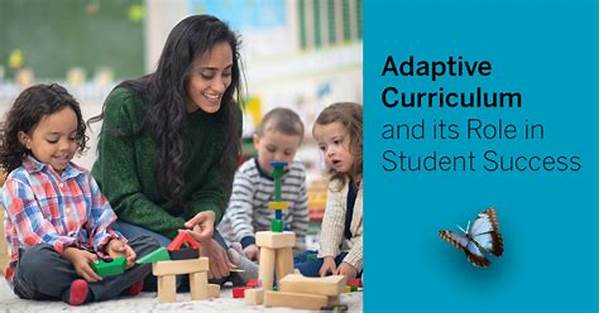In the ever-evolving field of education, one pedagogical approach that has garnered increasing attention is adaptive math teaching strategies. These methodologies are designed to cater to the unique learning needs of each student, thereby enhancing the teaching and learning experience. By leveraging technology and innovative instructional techniques, adaptive math teaching strategies strive to provide customized learning pathways that facilitate the comprehensive understanding of mathematical concepts for all learners.
Read Now : Weekend Classroom Activities Ideas
Importance of Adaptive Math Teaching Strategies
Adaptive math teaching strategies are pivotal in addressing the diverse learning needs present in today’s classrooms. By utilizing these strategies, educators can ensure that all students receive the support they need to excel in mathematics, regardless of their starting point. Tailored instructional approaches allow for real-time adjustments to the teaching material based on each student’s response, offering personalized challenges and support. This personalization can lead to improved student engagement and outcomes, as students are more likely to understand and retain mathematical concepts when taught in a manner that considers their individual strengths and weaknesses. Furthermore, adaptive math teaching strategies promote a growth mindset, encouraging students to embrace challenges and view failures as opportunities for growth. As a result, these strategies can help diminish the anxiety often associated with learning math, fostering a more positive learning environment. Ultimately, adaptive math teaching strategies are essential in cultivating an inclusive academic setting where each student can thrive in their mathematical journey.
Core Elements of Adaptive Math Teaching Strategies
1. Data-Driven Assessment: Central to adaptive math teaching strategies is the continuous assessment of student performance through data collection, allowing teachers to tailor instruction effectively.
2. Personalized Learning Paths: These strategies emphasize creating individualized learning experiences that accommodate each student’s unique needs, ensuring they receive appropriate challenges and support.
3. Technological Integration: Utilizing digital tools and platforms in adaptive math teaching strategies enhances learning by providing interactive and engaging ways of understanding math concepts.
4. Real-Time Feedback: Teachers provide immediate feedback, helping students promptly address mistakes and reinforce their understanding of mathematical principles within adaptive math teaching strategies.
5. Collaborative Learning: Encouraging group activities and projects allows students to learn from one another, fostering a community of collaborative problem-solvers within adaptive math teaching strategies.
Read Now : Startup Leadership Development Tools
Benefits and Challenges of Implementing Adaptive Math Teaching Strategies
The implementation of adaptive math teaching strategies offers numerous benefits, including increased student engagement and improved learning outcomes. By catering to individual learning styles, these strategies help students to better grasp complex mathematical concepts, thereby increasing their confidence and academic achievement. Additionally, adaptive math teaching strategies promote the development of critical thinking and problem-solving skills, as students learn to tackle math problems using various approaches. However, the successful adoption of these strategies also presents challenges. Educators must be equipped with the necessary training and resources to effectively integrate technology and data analysis into their teaching practices. Moreover, there is the challenge of ensuring equitable access to technology for all students, as disparities in resources can hinder the effective implementation of adaptive math teaching strategies. Therefore, educators and policymakers must collaborate to address these obstacles, ensuring that all students can benefit from adaptive learning environments.
Integrating Adaptive Math Teaching Strategies in the Classroom
Adaptive math teaching strategies can be successfully integrated into classroom settings by incorporating technology-assisted learning tools. Examples include intelligent tutoring systems that provide customized lessons and feedback to each student. Additionally, educators can employ learning management systems that track student progress, allowing for data-driven instructional adjustments. It is also beneficial to create a classroom environment that encourages exploration and inquiry, where students feel comfortable experimenting with different problem-solving methods. Teachers can facilitate discussions and group activities, providing opportunities for students to collaborate and learn from one another. Regular professional development sessions are essential for educators to stay abreast of new adaptive strategies and technological advancements. By fostering a culture of continuous learning, educators can effectively implement adaptive math teaching strategies, thereby enhancing the educational experience for all students.
The Role of Technology in Adaptive Math Teaching Strategies
The role of technology in adaptive math teaching strategies is significant, as it enables the customization of learning experiences to meet individual student needs. Through digital platforms, teachers can access a wealth of resources and tools that offer interactive and personalized math instruction. These platforms often include features such as formative assessments and analytics that provide insights into student performance, allowing teachers to adapt their teaching methods accordingly. Moreover, technology facilitates access to a wide range of instructional materials, from interactive simulations to video tutorials, catering to various learning preferences. Nevertheless, while technology is a powerful enabler of adaptive math teaching strategies, it must be used judiciously. Educators must ensure that technology complements, rather than replaces, traditional teaching methods. They should also be mindful of maintaining student engagement and interaction, using technology as a tool to enhance, rather than diminish, the dynamic human element of teaching. Path to achieving this involves ongoing training and support for educators, ensuring they are equipped to harness the full potential of technology in their teaching practices.
Summary of Adaptive Math Teaching Strategies
In conclusion, adaptive math teaching strategies represent a significant advancement in educational pedagogy, offering the potential to transform the way mathematics is taught and learned. By tailoring instruction to meet individual student needs, these strategies foster an inclusive and supportive learning environment where all students can achieve their full potential. Through the integration of technology, real-time feedback, and collaborative learning opportunities, adaptive math teaching strategies help students develop a deeper understanding of mathematical concepts while promoting critical thinking and problem-solving skills. Despite the challenges associated with implementing these strategies, such as ensuring equitable access to technology and providing adequate teacher training, the benefits they offer are substantial. By addressing these challenges, educators and policymakers can work towards creating adaptive learning environments that better serve the diverse needs of students, ultimately contributing to improved educational outcomes and a more equitable society.
